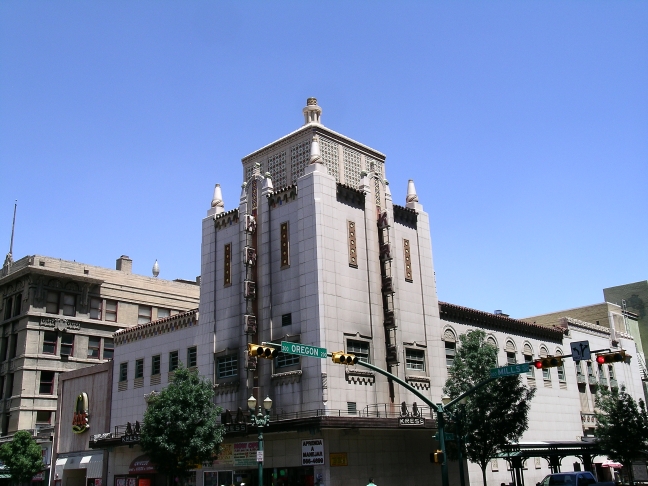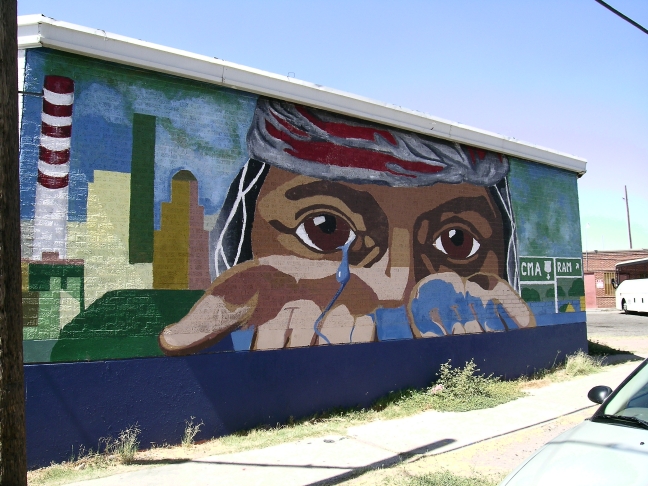Blue Highways: Playas, New Mexico
Unfolding the Map
Click on Thumbnail for MapA town is transformed, in the emptiness of New Mexico, from a collection of trailers when William Least Heat-Moon (LHM) drove through thirty years ago to a bustling company town to an abandoned set of buildings used for a training center focusing on terrorism. Thirty years is a long time, and a blink of an eye. Click on the map to see where this interesting New Mexico location is situated.
Book Quote
"For the fourth time that day, I crossed the Continental Divide, which at this point, was merely a crumpling of hills. The highway held so true that the mountains ahead seemed to come to me. Along the road were small glaring and dusty towns: Playas, a gathering of trailers and a one-room massage parlor ($3.00 for thirty-five minutes the sign said)...."
Blue Highways: Part 4, Chapter 12
 This is what your likely to see in Playas, New Mexico (also known as Terror Town) these days. Photo at the InfraNet Lab blog. Click on photo to go to host page.
This is what your likely to see in Playas, New Mexico (also known as Terror Town) these days. Photo at the InfraNet Lab blog. Click on photo to go to host page.
Playas, New Mexico
How things can change in thirty years. When LHM traveled through Playas thirty years ago, it was, as he describes above, "a gathering of trailers" and a massage parlor. Playas was located in a state, New Mexico, that is the fifth largest in terms of area in the nation, and the sixth smallest in terms of population density at 17 persons per square mile. Only South Dakota, North Dakota, Montana, Wyoming, and Alaska have less people per square mile than New Mexico. Of the two million people that live in New Mexico, over half of them live in the Albuquerque and Santa Fe metro areas. In other words, there is a whole lot of empty space in New Mexico.
In my frequent drives from Albuquerque to Lubbock in 2008-2009, I traveled through a lot of those empty spaces. Because business and commerce tends to cluster around freeways, one doesn't get a sense of just how empty New Mexico can be until one ventures off onto the blue highways that LHM writes of. Between Santa Rosa and Fort Sumner, I got a sense of just how empty New Mexico is. Also, if one, rather than driving northwest from Fort Sumner to the freeway, continues driving west, the emptiness is sublimely beautiful. Arid grasslands, with hardly a tree to be seen - just some scrub bushes here and there along with the lonely sound of a railroad horn.
Because of its relative emptiness, New Mexico is bursting with military and law enforcement training activity. Near Socorro, where New Mexico Tech's campus is located, the air force practices bombing runs with low flying planes. White Sands Missile Range, besides being the place where the first atomic bomb was tested, has been used to test rockets and missiles for military and peacetime activities. It is in some of these empty spaces, down by Truth or Consequences, that New Mexico has begun building an international spaceport which will be anchored by the activities of Virgin Galactic. In the next few years, the company plans to take tourists to the edge of space in a rocket-powered plane that will then glide back to earth after the space tourists experience about ten minutes of zero gravity.
One can find throughout New Mexico these lonely places. Where there are towns, they look like they are just barely hanging on to the edge of the world. I imagine that Playas was like that - a set of trailers that looked like they might be carried off by the next gust of wind, leaving nothing but a dirt devil their wake.
Today, however, Playas as a town is no more. According to its entry on Wikipedia, the town was begun as a company town for a copper smelter. All residents of the town were evicted in 1999 when the Phelps Dodge Company closed the plant. By then, the town had grown to include 250 homes, some apartments, a bar, bowling alley, a rodeo ring, and a fitness center. The town lay dormant, a skeleton crew its only inhabitants, until New Mexico Tech University purchased it in 2003. It is now used for training for counter-terrorism efforts, first responders, and for awhile, US military assisting Border Patrol agents. That last fact is a supreme irony, since the lights of the smelter has evidently been nicknamed by illegal immigrants crossing the border as La Estrella del Norte, or The Star of the the North.
Even as people take control of aspects of their lives through technology and commerce, some things, like time and market forces, are beyond control and may cause the birth and death of settlements, towns, villages, and even cities. We reach out to the stars, using man-made stars to guide our way north across borders in hopes of a new life, or using rocket fuel to take us to the brink of the void, and yet even as these activities are ongoing, towns are evicted, wars cause deaths, and natural earth movements fling towering waves of destruction against our strongly built, seemingly impervious structures.
But still we sit in the emptiness, look about us, and continue to work with what is while dreaming of what will be.
Musical Interlude
For today's musical interlude, since I wrote about stars, I go back to Terri Hendrix of Texas, and offer you her song Lluvia de Estrellas, which literally means "rain of stars" and is really a very poetic description of a meteor shower. Enjoy!
If you want to know more about Playas
Albuquerque Journal: N.M. Tech Buys Playas for Terror Training Center
Center for Land Use Interpretation: Playas
Washington Post: New Mexico Plays Home to Terror Town
Wikipedia: Playas
Next up: Animas, New Mexico




 Tuesday, March 15, 2011 at 6:52AM
Tuesday, March 15, 2011 at 6:52AM



